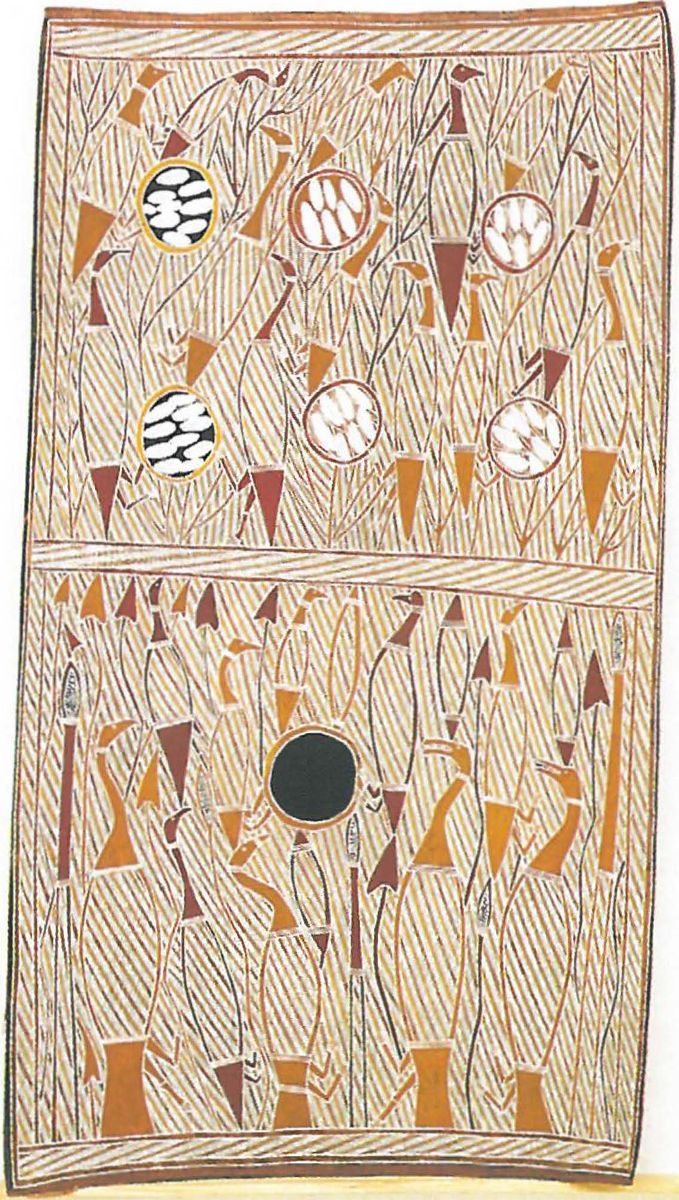.jpg)
Not distant bolts of tropical lightning, threat of 21st century war, nor the collapse of one of the country's airlines (leaving audiences stranded) could detract from the energy of this year's NATSIAA. It's a cracker!
It kicked off with a stunning ceremony under the stars on the verge between the Territory's Art Gallery and the waters of Fannie Bay. Judges Bernice Murphy and Michael Riley took centre stage along with various dignitaries, all welcomed by the Museum's ebullient new director Anna Malgorzewicz. Elders, out-of-towners, camera crews, art practitioners, art critics, local kids, the ubiquitous stray dog, all nudged shoulder to shoulder in a huge arc framing the bushfire and stage. When Telstra's CEO, Ziggy Switkowski, announced Warlpiri woman Dorothy Napangardi as this year's winner of the most handsome indigenous prize in the country, the crowd applauded then stood, mesmerised. Lean bodied Galiwinko Rapt-ja dancers from Elcho Island sporting red loin cloths and white body markings made their way from behind the stage. With antler-like spindly movements they serenaded Napangardi who looked on with pleasurable shyness. As each prize was announced the dancers performed a different narrative via wonderfully agile and evocative performance. While this was happening the answering machine belonging to Napangardi's manager was already fielding calls from buyers, some aware that her highly sought after paintings have featured in international exhibitions, others just keen to own one of her canvases.
Inside the Museum and Art Gallery, Napangardi's Salt on Mina Mina looked electric amidst an array of 67 paintings, some of the strongest this award has seen. Here her white grid of undulating lines triggered a dynamic play of collision and tension as they worked their way over receding patches of black. In this abstract canvas the traditional iconography from her familiar lines is no longer present; however the white dots depict encrustations of salt stretching to infinity, etched with the tracks of the women walking over the sacred ceremonial site of Mina Mina.

Patterned rhythmic surfaces also work to great effect in paintings by Minnie Motorcar Apwerl, Lena Nyadbi, Johnny Yungut Tjupurrula, and Prince of Wales who this year was awarded the Telstra General Painting Award. His Body Marks is made up of roughly executed paint daubs on a canvas of eccentric beauty and ceremonial presence.
This year the more traditional bark painting section set up a wonderfully hypnotic rhythm of cross-hatching and imagery attesting to the skill of contemporary artists working with this traditional medium. Many of the 13 grainy surfaces bearing natural pigments were a knockout. The final choice for the $4,000 Telstra Bark Painting Award went to John Bulunbulun's Magpie Geese, a painting of exacting execution, balance, and rhythm.
Paddy Japaljarri Stewart and Paddy Japaljarri Sims's Yuendumu Doors won the Telstra Work on Paper Award, for their suite of beautifully executed intimately scaled prints while Craig Koomeeta's Saltwater Crocodile won the Wandjuk Marika Three Dimensional Award. The life size creature lends this section humorous appeal with its funky mix of clunky carving, and Flintstone-style mark-making. Other treats in this section included an ensemble of Baldessin-like bronzed yams created by Brian Njinawanga and Mantatjara Wilson's beautiful well of woven coils that form an emu basket.
In the words of the judges "All works selected revealed intense observation, consideration, detailed inventiveness and sustained achievement. They emerge from various contexts, from ritual activities to daily observation of experiences in the world, to quite optical effects that come only with prolonged concentration and careful working, reaching their audiences in strikingly different ways, but are all marked by high quality of results."
Thankfully the prize winning pieces join the MAGNT's permanent collection; the only disappointment is that so many of the 128 works in this exhibition are worthy of such a place. Importantly, this year's choices highlight the outstanding quality to come from a variety of language groups. In turn this should raise the profile of Aboriginal artists nationally, and it is hoped bring prestige and economic benefits to the artists and their communities. That Telstra continues to support the National Aboriginal Torres Strait Islander Art Award is what has made it the most visible and important indigenous art prize in the country.













